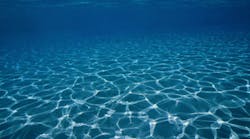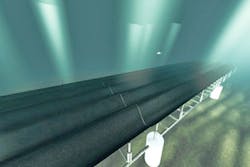Researchers at UC Berkeley are looking at a new way to harness the power of big ocean waves by developing a seafloor carpet system. For assistant professor Reza Alam, an expert in wave mechanics, the seafloor “carpet” he is proposing will convert ocean waves into usable energy.
“There is a vast amount of untapped energy in the oceans, and with increasing worldwide demand for power, the need to find cleaner alternatives to fossil fuels is critical,” said Reza Alam assistant professor at UC Berkeley. “We are also seeing greater population growth along coastal cities, so the ocean-based system we are developing would produce electricity in a carbon-neutral way right where it is needed.”
Marcus Lehmann, a Ph.D. researcher on Alam’s team, added that one potential application for their system could be to lower the high cost of purifying seawater into drinkable water, helping states – and countries – weather periods of drought.
The dominant methods of turning seawater into fresh water involve distillation, which requires heat, and reverse osmosis desalination, in which water is pumped through filters. Both methods use a substantial amount of energy that thus far has prevented their wider adoption. A power-generating system that is based on ocean power could change that, at least in areas of the world adjacent to high wave energy activity, the UC Berkeley researchers said.
The idea of tapping into ocean waves for power is not new. Alam’s lab cites an analysis from the London-based nonprofit Carbon Trust that wave energy could potentially provide more than 2,000 terawatt hours of electricity per year, or about 10 percent of global electricity needs.
Alam and his research team are proposing a wave-to-energy conversion system that sits on the seafloor.
“The benefit of having a system underwater is that there is minimal visual and physical impact on boats and sea life,” said Alam. “Our system would work with no problem in stormy conditions because the water column above the carpet buffers the impact momentum of surging waves. In fact, our carpet is even more efficient when ocean waves are stronger.”
Alam got the idea of creating a seafloor carpet from real-world muddy seabeds, which are known to dampen the energy of surface waves. While surfers would not find this appealing, boaters and fishermen regularly use such safe harbors to escape from destructive wave surges during strong storms. Alam noted that his seafloor carpet system would not be considered for use in popular surf zones.
To simulate the effects of a muddy seabed, the engineers used a thin sheet of rubber that sits on top of a grid of hydraulic actuators, cylinders and tubes. As the rubber carpet moves up and down with the waves, it pumps the cylinders, creating hydraulic pressure that is piped onshore to be converted into power.
The researchers noted that while rubber was used in the lab experiments, they would look to longer-lasting elastic composite materials when deploying a system in the ocean.
Early experiments with wave tanks at UC Berkeley have been promising. In results presented most recently at the 10th European Wave and Tidal Energy Conference in Denmark, the researchers showed that the wave carpet was able to absorb more than 90 percent of incoming wave energy.
Alam estimated that one square meter of a seafloor carpet system could generate enough electricity to power two U.S. households. He added that wave energy from just 10 meters of California coastline, or about 100 square meters of a seafloor carpet, could generate the same amount of power as an array of solar panels the size of a soccer field, which covers about 6,400 square meters.
Ideally, the system would be located in shallow coastal waters about 60 feet deep. The topography of the seafloor need not be flat, but areas with reefs would be avoided. Alam emphasized that, in the search for appropriate sites, they would look for areas that would not negatively impact marine life.
The researchers are considering whether the ever-growing number of nearshore “dead zones” – low-oxygen regions in the ocean with little marine life – would be strong candidates for pilot testing their system.
“We plan to start testing this system in the ocean within the next two years, and we hope to have it ready for commercial use within the next 10 years,” said Alam.
Funding for this research was provided by the American Bureau of Shipping. The researchers also set up a project site via Microryza, a crowdsourcing platform for research projects.


